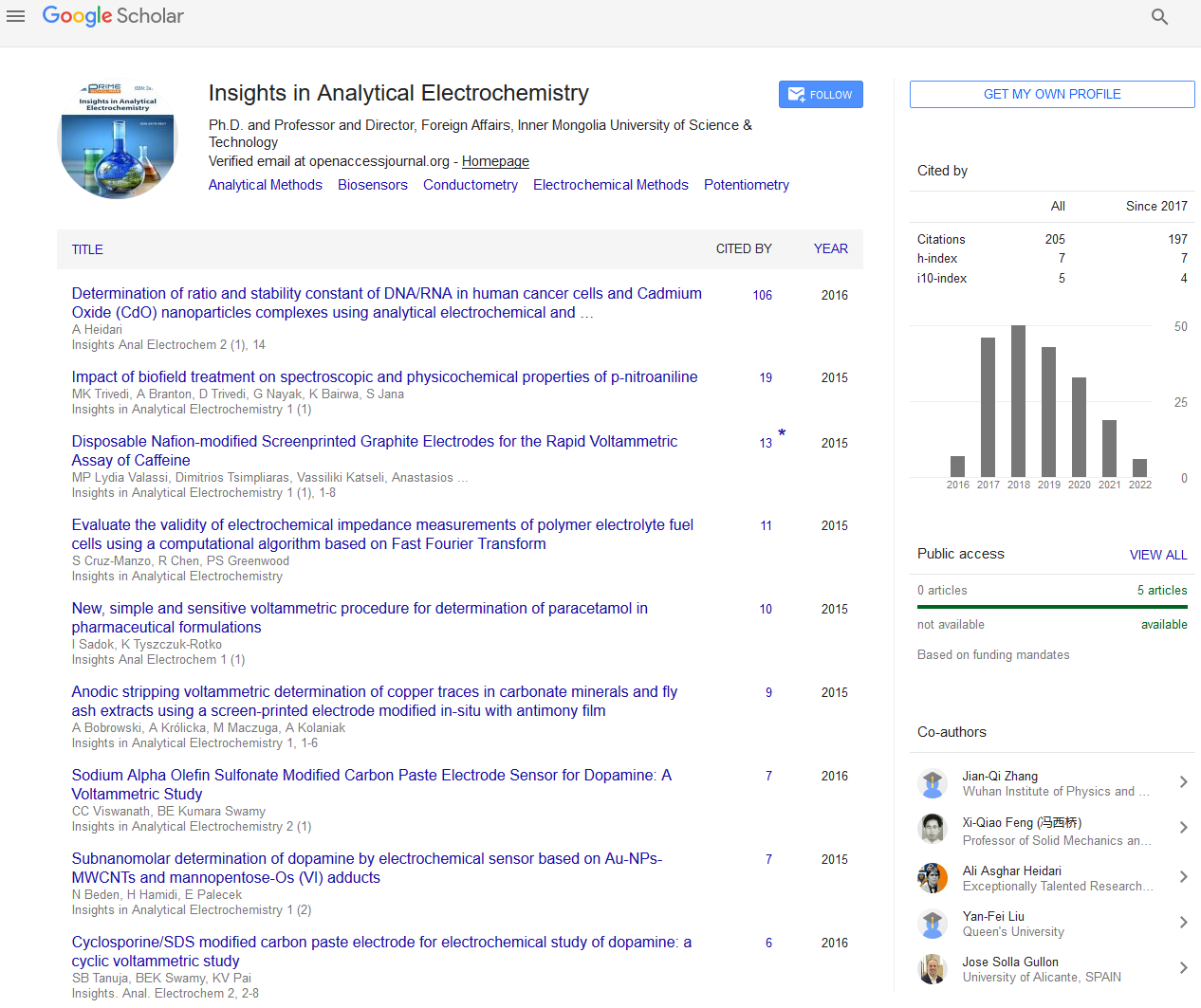Perspective - (2022) Volume 8, Issue 5
The Intensity of the Oxidation Current in Acetonitrile than Dichloromethane
Canping Pan*
Department of Applied Chemistry, China Agricultural University, China
*Correspondence:
Canping Pan,
Department of Applied Chemistry, China Agricultural University,
China,
Email:
Received: 31-Aug-2022, Manuscript No. IPAEI-22-14743;
Editor assigned: 02-Sep-2022, Pre QC No. IPAEI-22-14743 (PQ);
Reviewed: 16-Sep-2022, QC No. IPAEI-22-14743;
Revised: 21-Sep-2022, Manuscript No. IPAEI-22-14743 (R);
Published:
28-Sep-2022, DOI: 10.21767/2470-9867.22.8.25
INTRODUCTION
A sophisticated potentiometric and voltammetry technique is
cyclic voltammetry. Depending on the direction of the ramping
potential, the chemical undergoes either an electron loss
(oxidation) or an electron gain (reduction) during a scan. On
a platinum electrode, cyclic voltammetry (CV) is used. The
electrochemical behaviour of the obtained polymer is the primary
focus of the analysis, which examines the effects of two
solvents acetonitrile and dichloromethane. Cyclic voltammetry
and Electrochemical Impedance Spectroscopy (EIS) were
used to investigate this material’s electrochemical behaviour.
The polyterthiophene film can oxide and reduce in two different
solutions, as shown by the voltammograms. The intensity
of the oxidation current is more important in acetonitrile
than in dichloromethane. The semicircle that represents the
charge-transfer resistance at the electrode/polymer interface
at high frequency and the diffusion process at low frequency is
depicted in the impedance plots.
Description
Inorganic complexes’ reactivity is centered on electron transfer
processes. In cyclical phases, the electrode potential ramps
linearly with time in cyclic voltammetry (CV). The experiment’s
scan rate (V/s) is the rate at which voltage changes over time in
each of these phases. Between the working electrode and the
reference electrode, the potential is measured, and between
the working electrode and the counter electrode, the current
is measured. The applied potential (E, also known as just “potential”)
is plotted against the current value of these data. The
catholic current will decrease as the concentration of reducible
analyse decreases at some point after the analyze reaches
its reduction potential. The reduced analyse will begin to be
re-oxidized during the reverse scan (from t1 to t2) if the redox
couple is reversible, resulting in a current of reverse polarity
(anodic current) compared to before. The shape of the oxidation peak will be more similar to that of the reduction peak
the more reversible the redox couple is. As a result, CV data
can provide information about electrochemical reaction rates
and redox potentials. For instance, the peak current will be
proportional to the square root of the scan rate if the speed of
electron transfer at the working electrode surface is high and
the current is constrained by the diffusion of analyse species to
the electrode surface. The Randles–Sevcik equation provides a
description of this relationship. The diffusion layer at the electrode
surface is the only part of the solution that the CV experiment
samples in this case.
Conclusion
Research efforts aimed at developing technologies for renewable
energy now rely heavily on molecular electrochemistry.
The need for a new generation of trained electrochemists is
growing as the field develops rapidly. There are a number of
textbooks and online resources, as well as more and more
labs for undergraduate students, but there is no easy-to-understand
guide to cyclic voltammetry for inorganic chemists.
In order to provide a single introductory text that reflects the
most recent best practices for learning and utilizing cyclic voltammetry,
we update, improve upon, and streamline seminal
papers. Nonaqueous solvent-based examples and practical experiments
are provided to get inorganic chemists interested in
using electrochemical methods for their research started on
cyclic voltammetry experiments. The practical experiments in
this book serve as the foundation for our laboratory’s instruction
of new researchers.
Acknowledgement
None.
Conflict of Interest
The author's declared that they have no conflict of interest.
Citation: Pan C (2022) The Intensity of the Oxidation Current in Acetonitrile than Dichloromethane. Insights Anal Electrochem.8:25.
Copyright: © 2022 Pan C. This is an open-access article distributed under the terms of the Creative Commons Attribution License,
which permits unrestricted use, distribution, and reproduction in any medium, provided the original author and source are
credited.

